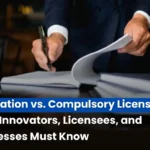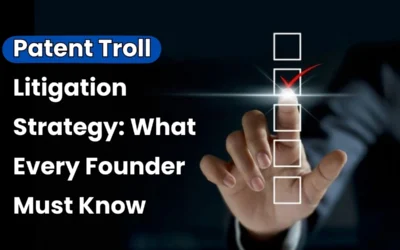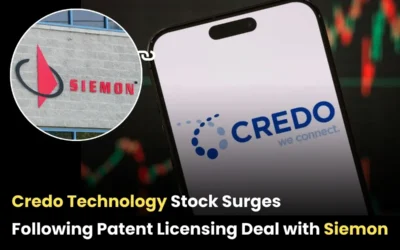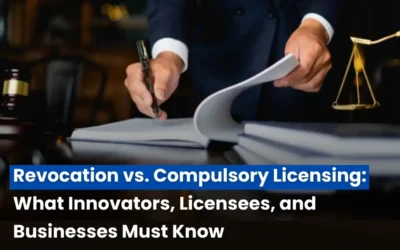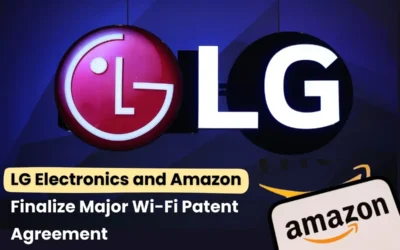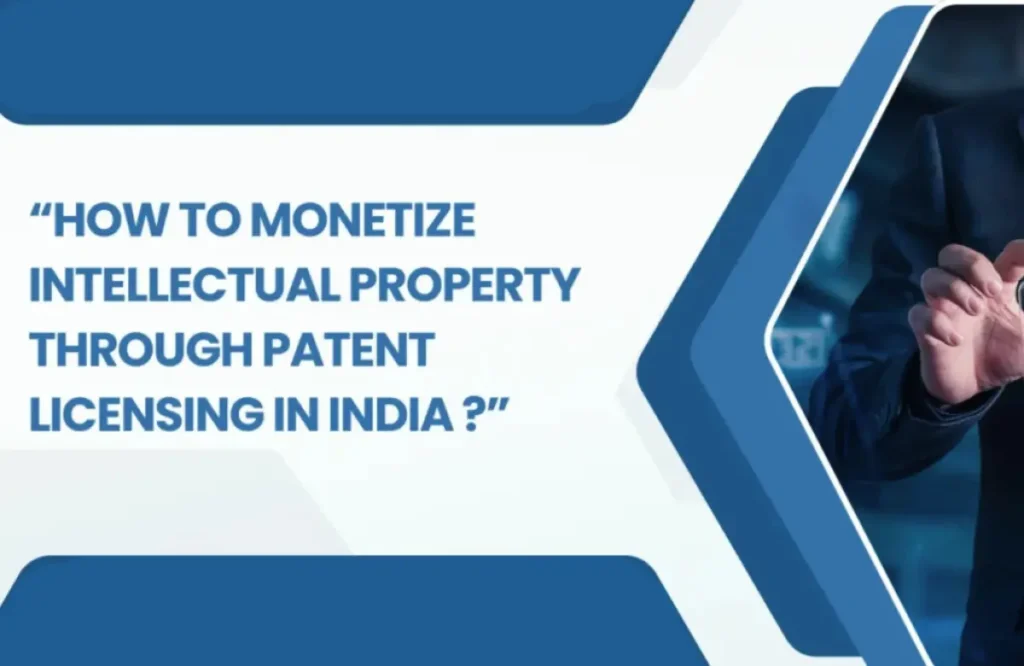
Intellectual property is the dynamic asset of any business in the present era of life. It guards and monetizes your innovations and, therefore leads to more lucrative opportunities to generate revenues. One of the most common methods of making money from intellectual property rights (IPR) is through patent licensing. This provides the scope of generating funds for patent holders because other people and organizations apply patented technologies or items with returns. Patent licensing has thus emerged as the newest and hottest trend in India because most businessmen and creators want to capitalize on their innovations to gain higher returns. We would be able to see how this is feasible with a patent license that capitalizes on intellectual property: Intellectual property monetization: Significance of Patents- which way it’s licensed, constitutes a legal framework on patents in the Indian context, taken care of, and along with that, the concerns related to this patent license or benefits.
Meaning of Patent Licensing
Patent licensing is a process whereby the patent holder grants the right to another entity to use, make, sell, or distribute a patented invention under mutually agreed-upon terms. The patent holder, often called the licensor, grants the license (is) to use the patented invention in exchange for the passage of some monetary compensation. This can be either royalties, a one-time payment, or both.
There are two types of patent licensing:-
- Licensing with an exclusive right: In the case of an exclusive license, the owner of a patent has exclusive with the license. This means that, during the period of licensing, others, even the patent owner himself, are prohibited from using the technology patented.
- Non-Exclusion License: Patent owner licensed by a non-exclusion license will provide an array of wide patent rights to licensees. On one side, it maintained his right to use patents and also license others.
Intellectual property monetization through Patent licensing?
1. A Perceptive Review
The most valuable property of the individual, business house, and organization in India is intellectual property. It is a group of intellectual products such as inventions, designs, and artworks. Among the various methods of raising revenue through IPs, the patent licensing method is the most significant. Patent licensing provides a source of income for patentees. A license enables other parties to use, make, or sell the patented invention. India has its patent licensing through the provisions of the Indian Patents Act, 1970. The paper will find out how the proprietors can have an opportunity for licensing so that this may help the licensors to find income both in terms of legal remedies and economic benefit from the intellectual property rights. Patent licensing is the agreement by another party to use, make, sell, or distribute an invention covered by a patent owned by a patent owner as a form of paying for such right. It is normally crafted with agreed-upon terms of royalty fees, lump sums, or any other terms agreed upon by the parties.
2. Know the Licensing Market
It can be known whether the patented invention would work with which market, and before entering patent licensing agreements, the inventor has to look for the following potentials:
Licensees, the inventor should find all those companies and people to whom the licensed technology is relevant. That is, it must be the idea of the inventor that there can be enough demand in the appropriate market because it solves an important problem, or he can add value for these licensees.
Competitive Landscape: Review competitors’ patents to avoid any patent infringement issues and understand whether one can get a license in the field or not.
3. Prepare License Agreement
A very well-framed patent licensing agreement is required to be able to safeguard the rights of the patent holder as well as the licensee. These comprise, among others, salient points considered to be important components:
- Scope of the license: The extent to which the licensee is allowed within the geographical limits and the nature of the field applied.
- Royalties structure: Determination of how such royalties are actually calculated and paid.
- Length of the License: Specify for how long the license will exist.
- Quality Control: Explain how the licensor would implement the patent to ensure the patent would strengthen the brand with the owner of the patent.
- Termination Provision: Identify what events would allow either party to end the license.
You may want to consult with a licensing attorney or patent agent to prepare a licensing agreement that will be legally binding as well.
4. Determine Licensing Fees
Patent licensing fees would vary drastically depending upon a number of factors that include:
- Type of Technology: Sophisticated technologies, such as pharmaceuticals or innovations of revolutionary nature, require higher royalty payments.
- Market Potential: The fees must be calculated upon the marketplace demand and the commercial potential for success of the invention.
- Negotiation Skills: Crucial to all in ensuring a fair royalty rate is the negotiation ability to ensure the profitability of the licensing deal.
The fee in India varies between 2% and 10% of gross sales, depending on the sales derived from the licensed technology. In very rare cases, it is above that figure if the invention happens to be more unique.
Read Also: How to Maximize the Value of Your Patent Through Smart Licensing Strategies
5. Protect Intellectual Property Rights
The Patent licensing agreement is to be strictly adhered to so as not to breach the agreement. About this, the patent owner should also take proper care to ensure compliance with the following:
- Royalty Payments: This needs to be done on dates that are agreed upon by both parties.
- Quality Control: Should be made at standards for quality agreed upon with the patent licensing agreement.
Remedy against Infringement: In the event of a third party infringing the patent, the patent owner has the right to take the infringer to court of law.
6. Licensing to Global Markets
Except for domestic licensing, Indian patent owners can license their patents at the global level. In jurisdictions where a patent is held, the patent owner can enter a global market and thereby attract international licensees, and consequently increase the revenue from patent licensing. International licensing may add complexity, however, in the form of diverse legal systems and languages.
Benefits of Patent Licensing
1. Generation of Revenue
Royalties are generated from the product invention or a business partner without any investment in manufacturing, marketing, or distribution. Patent holders are able to produce income streams without the costs of operation through licensing to an established company.
2. Market Expansion
Such potential has been derived as patent licensing in business gives ways to penetrate markets without requiring the installation of infrastructure. Such penetration with firms that have a prior market-based setup, market holdings can attain the geographical and also gain access to new product categories.
3. Risk Motivation
There is minimal financial risk to the owner of the patent pertaining to licensing. They are not all-in with the patent commercialization risk because the licensing lets them focus more on other business aspects as their IPs generate revenue for them. This is pretty light on the pockets, too, for start-ups and small businesses.
4. Brand Value
Licensing the patent to such known and reputed licensees would give an upscale to the reputation of the patent holder. That is, the invention commands serious commercial value and is picked up by majors.
Challenges of Patent Licensing?
1. Legal Complexities
Patent licensing in India can also raise strict legal complications. For example, when any licensing agreement provides stipulated terms, then the provisions of the Indian Patent Law as well as worldwide treaties, need to be adhered to. Such examples come in cases such as patent infringement and complications accompanying cross-border jurisdiction.
2. Market Uncertainty
Patent licensing is an entirely market-oriented operation and survives on revenues solely from the sources mentioned above. It becomes unviable when demand shifts, the economy slows down, and the technology in use becomes obsolete during the period.
3. Competition and Patent Trolls
Another thing patent holders need to be careful of is the growing number of patent trolls, or people who buy patents and ask real companies to pay licensing fees on them with no intention of doing anything with them. The value of a patent will go down by some percentage when confronted with the same kind of competition.
Read Also: USPTO Enhances Assignment Records Search: New Tool Replaces Legacy Systems by October 2025
Conclusion
Patent licensing also becomes a successful source of income for the Indian inventor and companies since it generates income for the inventors or businesses without fully assuming the risk of commercializing an invention. In that regard, the Indian patent system can protect inventions that could be licensed to others to earn remittances. This all ultimately depends upon the exhaustive research, effective market knowledge, well-prepared licensing contract, and control over the Intellectual property monetization. All these together enable the IP owners to draw the highest revenue possible for an investment and risk it to its minimum limit.



